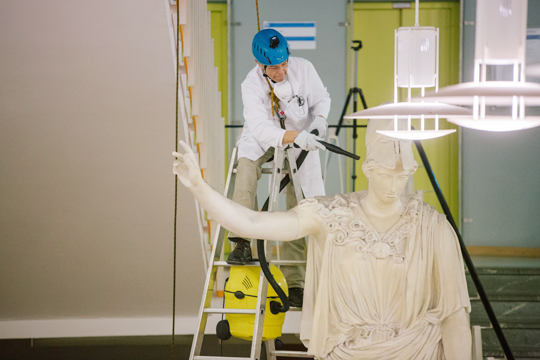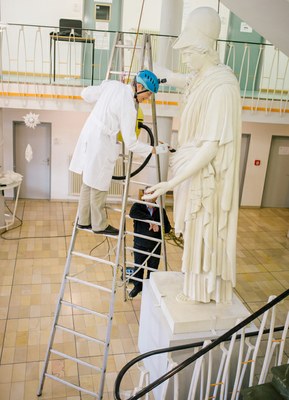Athena has been given a good brush off
Freiburg, Dec 13, 2017
She is tall, severe, beautiful – and pretty dirty: Athena, the statue looming well over three meters in height, has been watching over the foyer of the rectorate building for nearly twenty years now, perched atop a high pedestal. “And she hasn’t been cleaned since,” says Dr. Jens-Arne Dickmann, curator for the Archaeological Collection. The expert has been annoyed by the layer of dirt for some time now. Standing on a tall ladder, he has donned a helmet, overalls, face mask, vacuum cleaner, hand brush and paintbrush. On top of that, he was also secured with a harness and rope by his friend Rüdiger Braunbehrens. As the archaeologist set about his work to clean Athena, Rimma Gerenstein took a moment to chat with him.

Armed with a helmet, overalls and vacuum cleaner: Jens-Arne Dickmann cleans Athena. Photo: Sandra Meyndt
Mr. Dickmann, for the past 45 minutes you have been cleaning every fold and groove of Athena’s coat. Wouldn’t you rather be cleaning a sculpture of New Objectivity?
Jens-Arne Dickmann: Do you mean, for instance, the sculptures by Käthe Kollwitz? It’s true. They would be easier and quicker to clean – those are very reduced, clear forms. Nonetheless, I am finding it more interesting at the moment to be at eye level with Athena.
So you’re not afraid of heights. After all, Athena is about four meters from the ground.
No, I am not afraid of heights. I love to rock climb; every now and again I find myself 200 meters from the nearest ground. It’s all a question of focus. But I am certainly not a daredevil and I don’t take safety lightly. That’s why I asked my friend Rüdiger, with whom I often go rock climbing, if he would belay during the cleaning job. That way I know I am in good hands and won’t get nervous while standing on the top rung.

The vacuum cleaner is great for the first dry cleaning – the paintbrush and hand brush come into play for the finer parts. Photos: Sandra Meyndt
What do you notice in particular when looking at Athena up close and personal?
She is not in the best condition. And I don’t just mean the layer of dirt surrounding her. There is barely a place where the paint isn’t peeling. Entire slabs are coming off by the touch. We should actually scrape the entire layer of pain and then repaint it. Besides, I also see on the sculpture paint splashes, drops of plaster and traces of polluted water. Obviously the upper floors have been painted and plastered. And someone has overwatered the plants on occasion too.
2019558cd7fa312bd28d7bfd7ec5a1ac
Should the statue rather stand elsewhere?
When considering the climate conditions, the foyer in the rectorate is clearly an unfavorable location. The doors are constantly being opened and closed, which has an impact on the air humidity. Plaster is an extremely water-loving material - it absorbs moisture, expands and eventually leads to cracks. The sculpture should stand in a dry location to protect it. In the air-conditioned rooms in the Archaeological Collection we obviously have better conditions. But in terms of its effect, the statue is standing in the perfect position.
Athena, the warrior goddess?
Not just that. She is also the goddess of wisdom and skillfulness. As a high-class statue, it was built in the second half of the 5th century BC. Originally cast in bronze, centuries later it was struck in marble in a Roman workshop modeled on this model. This representation of Athena shows the goddess in a calm state, defensively armed, majestic and by no means emphatically feminine. Her composure embodies steadfastness and decisiveness and should have an impact. All of these characteristics fit well in a university setting. That is why it is important to me that the statue be maintained. If you place it in such a representative place merely as a neglected reminiscence of the Greek classics, the metaphor starts to get cracks too.

Nearly at eye level: Jens-Arne Dickmann works his way up, centimeter by centimeter. Photo: Sandra Meyndt
After three hours of cleaning, the statue has changed its color: The greyish-yellowish veil has given way to a soft eggshell white. Are you satisfied with the results?
It is definitely progress for now. You have to imagine that the statue hasn’t been cleaned in nearly twenty years – as long as it has been standing here. It wasn’t just my own personal beef. A lot of my colleagues have noticed the statue’s condition as well. I have removed the outermost layer of dirt, but I won’t be able to remove the dirt stuck to the plaster with merely a vacuum cleaner, hand brush and paintbrush. The next step would be a power wash, but that would take more than three hours.

